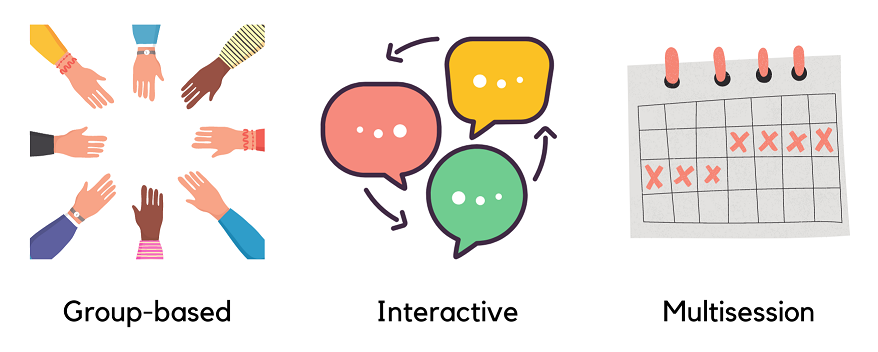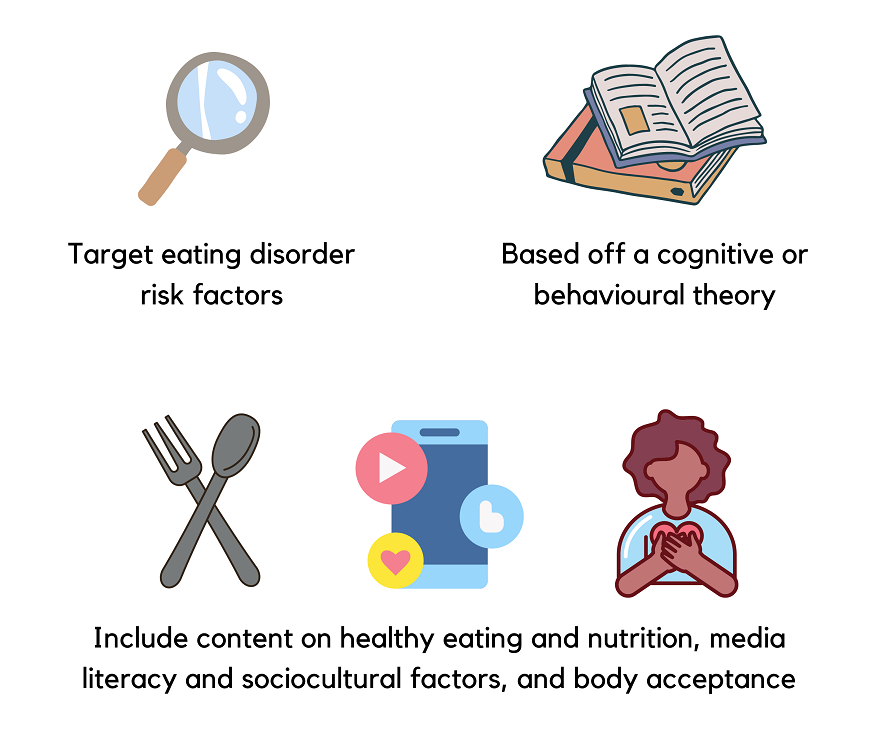
The goal of eating disorder prevention is to avoid or significantly delay the development of eating disorders (Levine et al., 2012). Rather than a “detect it-treat it” approach, prevention aims to:
Prevention can be broken down into 3 categories based on what part of the population is targeted: universal prevention, selective prevention, and targeted prevention.
The goal of universal prevention is to change government policies, social institutions, and normative cultural practices in order to prevent eating disorders and improve the public health of all members in a population. Examples include systemic actions to develop and implement laws to restrict the sales of over-the-counter dietary supplements for weight loss and muscle building (Austin et al., 2017). Universal prevention can include education and policy development and reinforcement.
NEDIC’s Community Education Programming includes workshops and panels that touch upon best practices in health and education policy. Our educational programming aims to increase your confidence in navigating information around food, weight, exercise, and health in a non-discriminatory manner.
Selective prevention aims to prevent eating disorders by targeting individuals in a population who are at a greater risk of developing eating disorders, such as children ages 8-11 within an elite ballet company (Piran, 1999). Selective prevention usually involves multisession, interactive, and educational interventions (Ciao et al., 2014).
Targeted prevention targets individuals who have been identified or screened as being at a high risk of developing eating disorders. Examples include girls ages 13-14 who have been screened to have a high degree of weight concerns (Killen, 1996). Targeted prevention can also involve multisession, interactive, and educational interventions.
Over the past two decades, eating disorder prevention research has grown rapidly. There are many studies conducting and evaluating how well eating disorder prevention programs work.
General findings from successful eating disorder prevention programs show that these programs can change individuals’ attitudes, knowledge, and behaviours associated with eating disorders. Below are some common features of successful prevention programs (Ciao et al., 2014):


To date, most research on eating disorder prevention has consisted of selective prevention programs originally developed for high-risk girls and women. There remains a need for continued research on successful universal prevention programs, as well as prevention programs for boys and men; Black, Indigenous, and People of Colour communities; and 2SLGBTQ+ individuals.
NEDIC has developed or contributed to the development of the following universal prevention programs.
Beyond Images is a turn-key curriculum developed by NEDIC and made possible with the generous support of the Dove Self-Esteem Project. The free online lesson plans for grades 4 through 8 fill a gap in media literacy curricula nationally and include activities that make a positive difference in combating appearance-based bullying and negative stereotypes. The curriculum provides the opportunity to explore key issues in today’s society around body image and self-esteem as well as media messaging, while developing critical thinking skills.
Beyond Images is available in French as Au-delà de l’image.
Learn more about Beyond ImagesBeing Me, Being Us, is an online resource to support body image promotion and mental health in schools. It supports students, teachers, school administrators, and school communities to all play a role in cultivating an environment where students feel confident and empowered in who they are. It includes lessons plans and supporting teaching materials for educators for grades 4 to 7, that connect to multiple subjects in the British Columbia curriculum and Social-Emotional Learning competencies.
This resource was developed by the British Columbia Ministry of Health and British Columbia Children’s Hospital in collaboration with subject matter experts across the education and health sectors, including NEDIC.
Developed by the Canadian Centre for Ethics in Sport, with contributions from NEDIC, BodySense is an interactive e-learning course for adolescent athletes. It is designed to: educate and enhance their awareness and knowledge on how to navigate body image; bring balance to both their physical and mental health; and work towards greater respect and compassion for their body within and outside of sport. BodySense includes self-reflection and self-assessment activities as well as tools, resources, and useful links for athletes to explore.
Learn more about BodySense